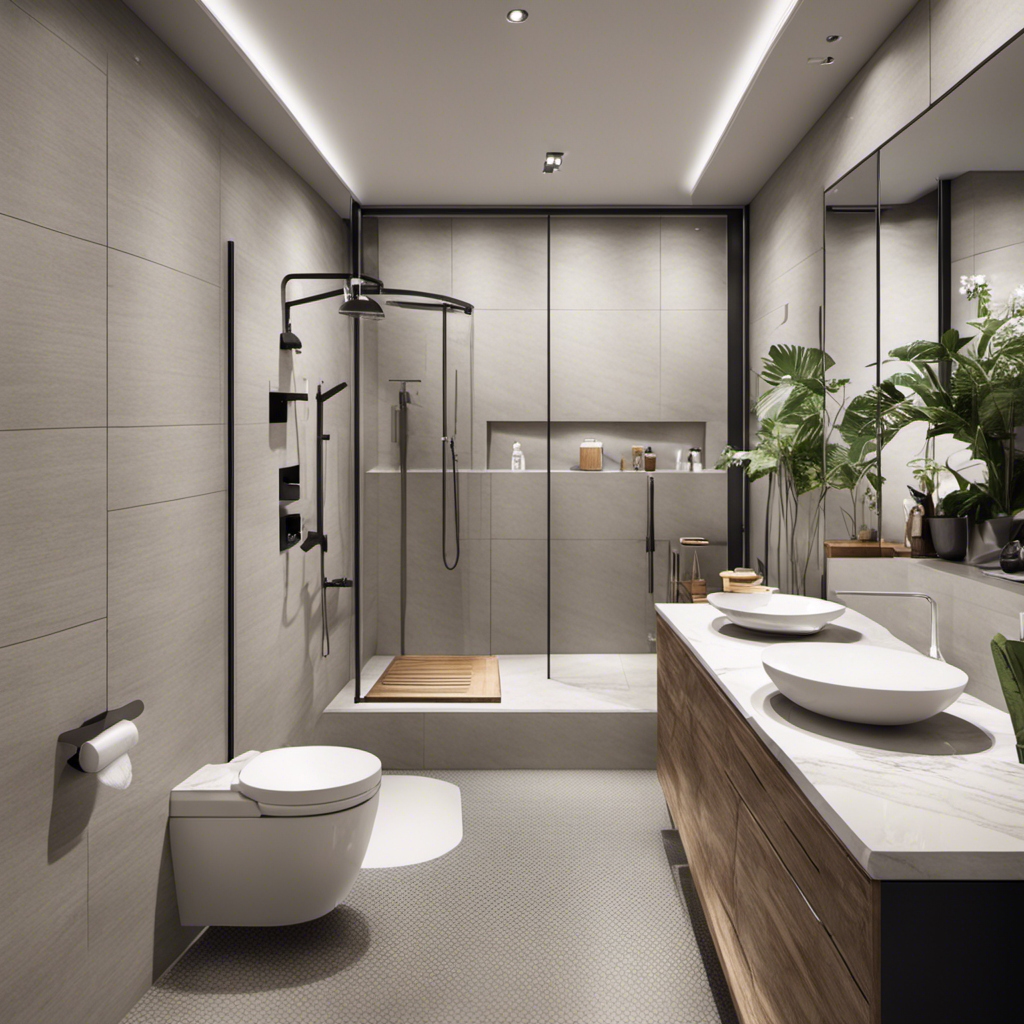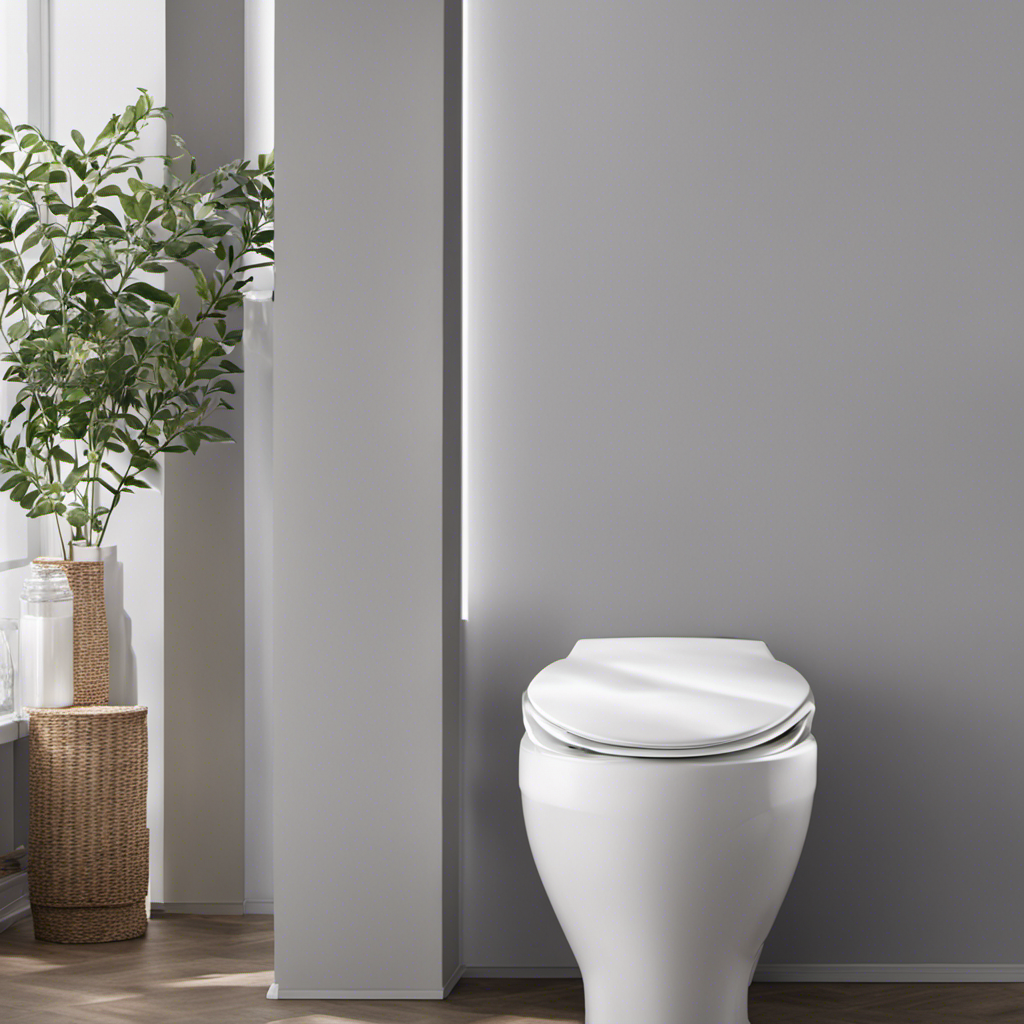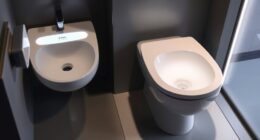I know what you’re thinking – venting a toilet sink and shower sounds like a complicated task. But trust me, it’s easier than you might think.
In this article, I’ll walk you through the steps to properly venting your bathroom fixtures. With the right tools and materials, you’ll be able to ensure proper ventilation and avoid any potential plumbing issues down the line.
So let’s get started and take the mystery out of venting your toilet sink and shower.
Key Takeaways
- Proper ventilation is essential for maintaining a healthy and functional plumbing system.
- Each fixture, including the toilet, sink, and shower, should have its own dedicated vent pipe to prevent clogs and foul odors.
- Understanding the basics of plumbing venting and adhering to plumbing codes is crucial for a well-functioning system.
- Regular inspection, cleaning, and maintenance of vent pipes can help prevent common ventilation issues such as clogs and decreased water flow.
The Importance of Proper Ventilation
You need to understand the importance of proper ventilation when it comes to venting your toilet, sink, and shower.
Proper ventilation plays a crucial role in maintaining a healthy and functional plumbing system.
One of the key benefits of proper ventilation is that it helps to prevent unpleasant odors from lingering in your bathroom.
Ventilation also helps to remove excess moisture, which can lead to mold and mildew growth if left unchecked.
Additionally, proper ventilation ensures that air pressure is balanced, preventing issues such as gurgling drains or slow drainage.
On the other hand, the consequences of poor ventilation can be quite significant.
Without proper ventilation, you may experience foul odors, increased humidity, and even clogged pipes.
It is essential to prioritize proper ventilation to maintain a clean and efficient plumbing system.
Understanding the Basics of Plumbing Venting
When plumbing, it’s important to have a basic understanding of how venting works. Proper venting is essential for a well-functioning plumbing system, as it helps prevent sewer gases from entering the living space and allows wastewater to flow freely. Here are some key points to understand about plumbing venting:
-
Purpose of vents: Vents serve two main purposes – to provide air circulation in the drainage system and to equalize pressure, ensuring smooth drainage and preventing traps from being siphoned.
-
Types of vents: There are various types of vents, including individual fixture vents, branch vents, and main vents. Each serves a specific purpose and must be installed according to plumbing codes.
-
Venting requirements: Plumbing codes dictate the minimum size and location of vents. It’s important to understand these requirements to ensure compliance and avoid common venting problems.
-
Common venting problems: Inadequate or improper venting can lead to issues such as slow drainage, gurgling sounds, foul odors, and even sewer backups. Understanding these common problems can help diagnose and resolve venting issues effectively.
Having a good understanding of plumbing venting basics and adhering to plumbing codes is crucial for a well-functioning plumbing system and to avoid common venting problems.
Tools and Materials Needed for Venting a Toilet, Sink, and Shower
When it comes to venting a toilet, sink, and shower, there are a few essential tools that you will need to ensure proper ventilation. These tools include a vent pipe, fittings, and a vent cap.
In addition to the tools, it is important to use the right materials for venting, such as PVC pipes and rubber couplings, to ensure a secure and leak-free installation.
Essential Venting Tools
To properly vent a toilet, sink, and shower, it is essential to have the right tools. Here are the essential tools you’ll need for venting:
-
Vent Pipe: This is the main component of a plumbing vent system. It allows air to enter the plumbing system, preventing suction and ensuring proper drainage.
-
Vent Cap: This is installed on top of the vent pipe to prevent debris, animals, or rainwater from entering the vent system.
-
Vent Tee: This fitting connects the vent pipe to the drain pipe. It allows air to flow freely while preventing sewer gases from escaping into your home.
-
Vent Boot: This is used for venting fixtures through the roof. It seals the hole around the vent pipe to prevent leaks.
By having these tools on hand, you can ensure that your toilet, sink, and shower are properly vented, meeting all the venting requirements.
And in case you encounter any issues, these troubleshooting tips will come in handy.
Proper Materials for Venting
The materials needed for proper venting include a vent pipe, vent cap, vent tee, and vent boot. Venting is a crucial aspect of plumbing systems, ensuring the smooth flow of waste and preventing the buildup of harmful gases.
When it comes to venting materials, there are different types of vents available, each serving a specific purpose. The vent pipe is the main component, responsible for carrying the sewer gases safely away from the home. It should be installed vertically and extend above the roofline.
The vent cap is placed at the top of the vent pipe to prevent debris and animals from entering. The vent tee allows for the connection of multiple fixtures to a single vent pipe. Lastly, the vent boot is used to seal the vent pipe where it protrudes through the roof.
Venting for Each Fixture
Each fixture in your home requires proper venting to ensure the smooth flow of waste and prevent the buildup of harmful gases. When it comes to venting a toilet, sink, and shower, there are a few key considerations to keep in mind:
-
Proper installation: It’s crucial to install the vent pipes correctly to allow for adequate airflow. This involves ensuring the pipes are angled correctly and connected to the main vent stack.
-
Toilet venting: The toilet should have its own dedicated vent pipe that extends through the roof. This helps prevent sewer gases from entering your home and allows for efficient flushing.
-
Sink venting: The sink should also have its own vent pipe that connects to the main vent stack. This prevents issues such as gurgling drains and slow drainage.
-
Shower venting: Similar to the sink, the shower should have its own vent pipe to prevent clogs and odors. It’s important to ensure the vent pipe is properly sized to handle the amount of water being drained.
Common problems with venting fixtures can include improper installation, clogs in the vent pipes, and leaks. Regular maintenance and inspections can help identify and resolve these issues, ensuring the proper functioning of your plumbing system.
Step-by-Step Guide to Venting a Toilet Sink and Shower
Proper venting techniques are essential for maintaining a healthy and functional plumbing system. By ensuring that your plumbing fixtures are properly vented, you can prevent issues such as sewer gas odors, slow draining sinks, and gurgling toilets.
However, there are some common ventilation mistakes that homeowners often make, which can lead to these problems and more.
Proper Venting Techniques
To achieve proper venting, it’s essential to understand the different techniques for venting a toilet, sink, and shower. Here are some key venting techniques and troubleshooting tips to ensure your plumbing system works efficiently:
-
Individual Venting: Each fixture, such as a toilet, sink, or shower, should have its own vent pipe connected to the main vent stack. This allows proper air circulation and prevents sewer gases from entering your home.
-
Wet Venting: This technique involves using a single vent pipe to serve multiple fixtures. It can be a cost-effective option but requires careful design and sizing to ensure adequate ventilation.
-
Air Admittance Valves (AAVs): AAVs are one-way valves that allow air to enter the plumbing system when needed, preventing negative pressure and maintaining proper venting.
-
Troubleshooting Tips: If you experience slow drainage or gurgling sounds, check for clogs or blockages in the vent pipes. You may need to clean or repair the vents to restore proper venting.
Common Ventilation Mistakes
One common mistake people make when it comes to ventilation is neglecting to check for clogs or blockages in the vent pipes, which can lead to slow drainage and gurgling sounds. Proper ventilation is essential for the efficient operation of plumbing systems. A lack of proper ventilation can result in a range of common ventilation problems, such as foul odors, water backups, and decreased water flow. To address these issues and ensure good ventilation, it is important to regularly inspect and clean the vent pipes. This can be easily done by using a plumber’s snake or a high-pressure water jet to remove any blockages. Additionally, installing vent screens can help prevent debris from entering the vent pipes and causing future clogs. By addressing these common ventilation problems, you can ensure the smooth and efficient operation of your plumbing system.
| Common Ventilation Problems | Solutions for Poor Ventilation |
|---|---|
| Foul odors | Regularly clean vent pipes |
| Water backups | Install vent screens |
| Decreased water flow | Use plumber’s snake or jet |
Now that we have covered common ventilation mistakes and their solutions, let’s move on to discussing common issues and troubleshooting tips for venting.
Common Issues and Troubleshooting Tips for Venting
If you’re having issues with venting your toilet, sink, or shower, there are a few troubleshooting tips you can try. Venting problems can lead to unpleasant odors, slow drainage, and even potential health hazards. To help you resolve these issues, here are some effective troubleshooting techniques:
-
Check for blockages: Clogs in the vent pipe can disrupt proper airflow. Use a plumber’s snake or a high-pressure water jet to remove any debris.
-
Inspect the vent pipe: Ensure that the vent pipe is not damaged or disconnected. Repair or replace any sections as necessary.
-
Verify venting regulations: Different regions have specific venting requirements. Make sure your venting system complies with local building codes.
-
Consider professional help: If troubleshooting doesn’t solve the problem, it’s best to consult a licensed plumber who can diagnose and fix the issue accurately.
Tips for Maintaining Proper Ventilation in Your Bathroom
Make sure you regularly clean the exhaust fan in your bathroom to maintain proper ventilation and prevent any buildup of dust or debris. Proper maintenance of your bathroom ventilation system is essential for improving air circulation and ensuring a healthy environment. Here are some tips for maintaining proper bathroom ventilation:
-
Clean the exhaust fan regularly: Dust and debris can accumulate on the fan blades, reducing its efficiency. Regularly clean the fan to ensure it functions properly.
-
Check and clean the vent ducts: Over time, vent ducts can become clogged with dust and other debris. Inspect and clean the ducts to ensure proper airflow.
-
Replace filters: Some bathroom ventilation systems have filters that need to be replaced regularly. Check the manufacturer’s instructions and replace filters as recommended.
-
Keep the bathroom door open: Leaving the bathroom door open while using the shower or bath allows for better air circulation and helps prevent moisture buildup.
Frequently Asked Questions
Can I Use the Same Vent for the Toilet, Sink, and Shower?
Yes, you can use separate vents for the toilet, sink, and shower. This is necessary to prevent sewer gases from entering your home and to ensure proper drainage and ventilation for each fixture.
Is Venting a Toilet, Sink, and Shower a DIY Project or Should I Hire a Professional Plumber?
Venting a toilet, sink, and shower can be a DIY project, but hiring a professional plumber ensures expertise and prevents costly mistakes. Consider the cost comparison and weigh the benefits before making a decision.
How Often Should I Check and Clean the Vents in My Bathroom?
I check and clean the vents in my bathroom every six months. Regular maintenance is important to ensure proper ventilation and prevent any issues. It’s a DIY task that helps maintain a healthy and efficient bathroom.
What Are the Signs of a Blocked or Improperly Vented Toilet, Sink, or Shower?
If a toilet, sink, or shower is blocked or improperly vented, common signs include slow drainage, gurgling noises, foul odors, and backups. Troubleshoot by checking for clogs, clearing vents, or calling a plumber.
Are There Any Alternative Methods for Venting a Toilet, Sink, and Shower?
There are alternative methods for venting a toilet, sink, and shower. These methods have their own benefits and drawbacks. It is important to consider these options before deciding on the best venting solution.
Conclusion
In conclusion, proper ventilation is essential for a well-functioning bathroom. By understanding the basics of plumbing venting and following a step-by-step guide, you can successfully vent your toilet, sink, and shower.
Remember to use the necessary tools and materials and troubleshoot any common issues that may arise. As the saying goes, ‘A breath of fresh air can make all the difference.’ So, ensure you maintain proper ventilation in your bathroom to create a clean and comfortable space for all.










